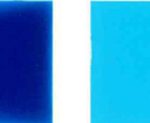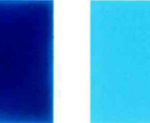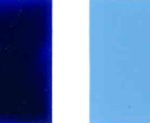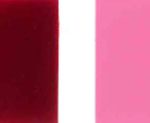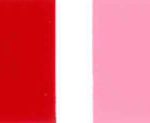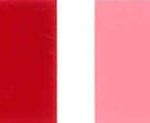ਪਿਗਮੈਂਟ ਨੀਲਾ 15: 0-ਕੋਰਿਮੈਕਸ ਬਲੂ 6850 ਪੀ
Technical parameters of Pigment blue 15:0
| ਰੰਗ ਇੰਡੈਕਸ ਨੰ. | ਪਿਗਮੈਂਟ ਨੀਲਾ 15: 0 |
| ਉਤਪਾਦ ਦਾ ਨਾਮ | ਕੋਰੀਮੈਕਸ ਬਲੂ 6850 ਪੀ |
| ਉਤਪਾਦ ਸ਼੍ਰੇਣੀ | ਜੈਵਿਕ ਪਿਗਮੈਂਟ |
| ਹਲਕਾ ਤੇਜ (ਪਰਤ) | 7 |
| ਗਰਮੀ ਪ੍ਰਤੀਰੋਧ (ਪਰਤ) | 180 |
| ਲਾਈਟ ਫਾਸਨੇਸ (ਪਲਾਸਟਿਕ) | 7-8 |
| ਗਰਮੀ ਪ੍ਰਤੀਰੋਧ (ਪਲਾਸਟਿਕ) | 220 |
ਰੰਗ |  |
| ਹਯੂ ਡਿਸਟਰੀਬਿ .ਸ਼ਨ |
ਫੀਚਰ: ਚੰਗੀ ਫੈਲਾਅ, ਉੱਚ ਰੰਗ ਤਾਕਤ.
ਐਪਲੀਕੇਸ਼ਨ :
ਆਰਕੀਟੈਕਚਰਲ ਕੋਟਿੰਗਸ, ਉਦਯੋਗਿਕ ਪੇਂਟ, ਪਾ powderਡਰ ਕੋਟਿੰਗਸ, ਪ੍ਰਿੰਟਿੰਗ ਪੇਸਟਸ, ਪੀਵੀਸੀ, ਰਬੜ, ਪੀਐਸ, ਪੀਪੀ, ਪੀਈ, ਆਫਸੈੱਟ ਸਿਆਹੀਆਂ, ਪਾਣੀ ਅਧਾਰਤ ਸਿਆਹੀਆਂ ਲਈ ਸਿਫਾਰਸ਼ ਕੀਤੀ ਜਾਂਦੀ ਹੈ.
ਪੀਐਸ, ਯੂਵੀ ਸਿਆਹੀ 'ਤੇ ਲਾਗੂ ਕੀਤਾ ਜਾ ਸਕਦਾ ਹੈ.
Detailed Characteristics:
Chemical Structure:
Pigment Blue 15:0 is a copper(II) complex with the phthalocyanine ligand.
It forms a planar macrocyclic structure with extensive conjugation, contributing to its deep blue color.
Physical Properties:
Molecular Weight: 576.08 g/mol
Density: Approximately 1.6 g/cm³
Melting Point: It sublimates without melting under normal atmospheric conditions.
Solubility: Insoluble in water and most organic solvents, which enhances its stability in various applications.
Synthesis:
Method: Typically synthesized by cyclotetramerization of phthalonitrile in the presence of a copper salt (e.g., copper(I) chloride) under high-temperature conditions. This reaction forms the phthalocyanine ring structure with copper at the core.
Properties:
Lightfastness: Exceptional lightfastness, making it highly resistant to fading under prolonged exposure to light.
Chemical Stability: Resistant to acids, alkalis, and organic solvents, ensuring durability in harsh environments.
Heat Stability: Can withstand high temperatures without significant degradation, suitable for various high-temperature applications.
Color Characteristics: Deep, intense blue color with high tinting strength, providing vivid coloration even at low concentrations.
Applications:
1.Paints and Coatings:
Used in automotive, industrial, and architectural coatings for its brilliant color and durability.
Also employed in artist paints, offering vibrant hues and longevity.
2.Plastics:
Utilized in the production of colored plastics, such as polyethylene, polypropylene, and polystyrene.
Its high stability ensures that the color remains consistent during plastic processing.
3.Inks:
Widely used in printing inks for packaging, textiles, and publications due to its bright color and resistance to bleeding.
4.Textiles:
Applied in textile printing and dyeing processes to achieve vibrant and long-lasting blue shades.
Used in both synthetic and natural fibers.
5.Rubber and Elastomers:
Incorporated into rubber products to impart color without affecting the material's properties.
Variants:
Pigment Blue 15:1: Beta form, known for improved dispersion and slightly greener shade.
Pigment Blue 15:2 to 15:6: Various crystalline modifications offering different hues, dispersion characteristics, and specific application advantages.
Safety and Handling:
Toxicity: Generally considered non-toxic; however, inhalation of dust should be avoided.
Safety Measures: Use personal protective equipment (PPE) such as gloves, masks, and goggles to prevent inhalation and skin contact during handling.
Environmental Impact: It is relatively inert and does not pose significant environmental hazards; however, standard environmental safety practices should be followed to prevent accidental release.
Environmental and Regulatory Aspects:
Regulations: Complies with various international safety standards for use in consumer products.
Environmental Impact: Considered environmentally benign due to its insolubility and stability, which minimizes its potential for bioaccumulation.
Pigment Blue 15:0's excellent stability, vibrant color, and wide range of applications make it a valuable pigment in many industries, serving as a base for more specialized variants and products.


